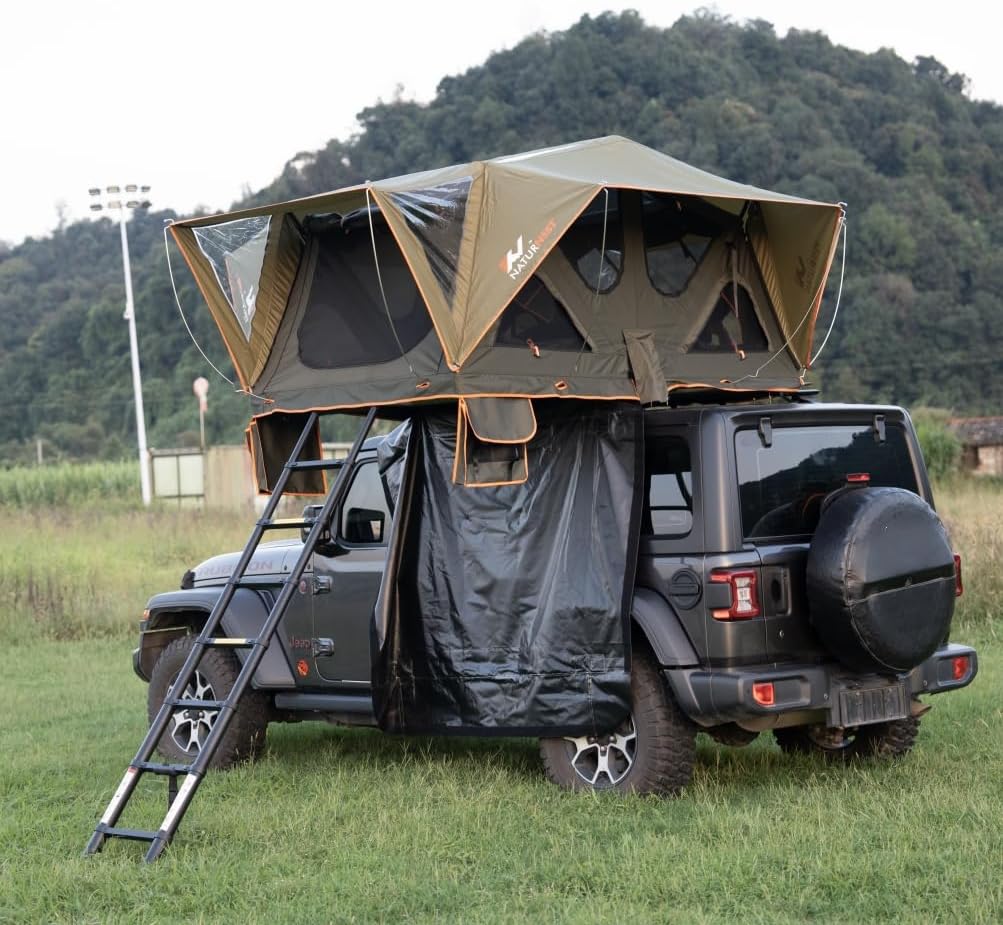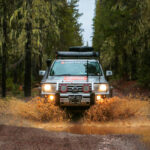Overlanding is no longer just a niche hobby; it has become a global movement among adventurers, campers, and outdoor enthusiasts. A key element of this lifestyle is reliable, comfortable, and practical sleeping arrangements. Among the various options available, overlanding rooftop tents have emerged as a popular choice due to their convenience, portability, and safety. In this comprehensive guide, we will explore the best options, advantages, drawbacks, and essential considerations for choosing the right rooftop tent for your overlanding adventures.
- Introduction to Overlanding Rooftop Tents
- Benefits of Overlanding Rooftop Tents
- Best Overlanding Rooftop Tent Options
- Key Features to Consider When Buying a Rooftop Tent
- Rooftop Tent Pros and Cons
- Overland Tent Setup: Tips and Best Practices
- Essential Rooftop Camping Gear
- Frequently Asked Questions (FAQ)
- Conclusion & Call-to-Action
Introduction to Overlanding Rooftop Tents
Overlanding combines off-road travel with self-reliance and adventure. Unlike conventional camping, overlanders often traverse remote areas where ground conditions may be unpredictable. This is where overlanding rooftop tents shine. Mounted on the roof of a vehicle, these tents offer elevated sleeping arrangements, protection from the elements, and quick setup, making them ideal for road trips, weekend excursions, and long-term overland expeditions.
The primary appeal of rooftop tents lies in their convenience and versatility. They allow adventurers to explore new terrains without worrying about uneven or wet ground, insect infestations, or limited camping spots. By integrating the tent directly with the vehicle, overlanders can maximize mobility, reduce setup time, and enjoy a higher level of comfort compared to traditional ground tents.
Benefits of Overlanding Rooftop Tents
Convenience and Ease of Setup
One of the standout benefits of overlanding rooftop tents is the speed and ease of setup. Unlike ground tents that require staking, leveling, and careful planning, rooftop tents are designed for quick deployment. Most modern models can be set up in under five minutes, allowing travelers to focus more on adventure rather than logistics.
Overland tent setup typically involves mounting the tent to a roof rack, unfolding the base, and extending the ladder. This streamlined process minimizes the hassle of searching for suitable ground and ensures you are ready to sleep safely, even after a long day of travel.
Comfort and Protection
Sleeping above the ground provides multiple comfort advantages. Elevated positioning ensures that the tent remains dry during rain, avoids contact with insects, and keeps occupants safe from small wildlife. Additionally, rooftop tents often feature built-in mattresses, allowing for a more restful sleep than traditional camping mats.
Many rooftop tents also include features such as insulated walls, mosquito netting, and rain covers, which enhance the overall comfort and protection for overlanders.
Portability and Compatibility
Another significant advantage is the portability and compatibility with a variety of vehicles. Overlanding rooftop tents can be installed on SUVs, trucks, and off-road vehicles equipped with compatible roof racks. This flexibility allows adventurers to adapt their sleeping arrangements to their preferred vehicle and overlanding style.
Furthermore, the compact design ensures that the tent does not interfere with the storage of other essential gear, maintaining vehicle balance and road safety.
Best Overlanding Rooftop Tent Options
Choosing the right rooftop tent requires careful consideration of features, budget, and intended usage. Here, we categorize the options into premium, mid-range, and budget choices.
Premium Rooftop Tents
Premium rooftop tents are designed for adventurers seeking the highest level of comfort and durability. These models often include:
- Reinforced aluminum or steel frames
- High-quality weather-resistant fabrics
- Thick, comfortable mattresses
- Built-in awnings for extra coverage
Pros: Exceptional durability, advanced features, comfort
Cons: High cost, heavier weight
Popular Models:
- iKamper Skycamp – Features a spacious interior and fast setup.
- Thule Tepui HyBox – Offers excellent insulation and compact storage.
Mid-Range Rooftop Tents
Mid-range tents provide a balance between affordability and performance. They often feature durable fabrics, reliable frames, and adequate protection against weather.
Pros: Balanced features, moderate price, suitable for frequent travelers
Cons: Slightly longer setup, fewer luxury features
Popular Models:
- Yakima SkyRise – Compact, easy to install, and reasonably priced.
- ARB Simpson III – Robust design for extended overlanding trips.
Budget Rooftop Tents
Budget rooftop tents are ideal for beginners or occasional overlanders who want a functional solution without breaking the bank. While lightweight and cost-effective, they maintain essential safety and comfort standards.
Pros: Affordable, lightweight, practical
Cons: Limited features, shorter lifespan
Popular Models:
- Smittybilt Overlander – Affordable and reliable for weekend adventures.
- Tepui Explorer Kukenam – Compact, easy to carry, suitable for small vehicles
Key Features to Consider When Buying a Rooftop Tent
Selecting the best rooftop tent requires careful attention to various factors. Here are the primary considerations:
Size and Sleeping Capacity
Choose a tent that accommodates the number of travelers comfortably. Rooftop tents typically sleep 2–4 people. Some premium models even support families with multiple occupants.
Weight and Vehicle Compatibility
Verify that your vehicle’s roof rack can support the tent’s weight, including occupants. Most rooftop tents weigh between 100–200 lbs, but heavier models may require reinforced racks.
Material Quality and Durability
Durable fabrics such as ripstop polyester and waterproof coatings ensure longevity. Reinforced aluminum frames increase stability, especially in rugged conditions.
Weather Resistance
Look for tents with excellent wind and rain resistance. Features such as rainfly covers, ventilated mesh, and waterproof zippers are critical for harsh weather.
Additional Accessories and Gear
Consider accessories like ladders, awnings, annex rooms, and storage pockets. These enhance comfort and provide versatile camping options.
Internal Link: For additional gear essentials, refer to our Overlanding Gear Essentials: Must-Have Equipment for Every Trip.
Rooftop Tent Pros and Cons
When evaluating rooftop tents, it’s important to weigh both advantages and disadvantages.
Advantages
- Quick and easy setup
- Elevated sleeping area provides safety and comfort
- Durable and weather-resistant options available
- Portable and compatible with most off-road vehicles
Disadvantages
- Higher initial cost compared to ground tents
- Additional weight on the vehicle roof
- Storage and transport considerations
- Limited space compared to traditional tents
Including these pros and cons helps overlanders make informed decisions tailored to their needs.
Overland Tent Setup: Tips and Best Practices
Proper setup is crucial for safety, comfort, and longevity of the rooftop tent. Follow these steps for an optimal setup:
- Choose a Stable Parking Spot – Flat, even terrain is ideal. Avoid soft soil or steep inclines.
- Secure Roof Rack and Tent – Ensure that the roof rack is properly installed and can support the tent’s weight.
- Deploy Tent – Unfold the base and extend the ladder. Ensure all locking mechanisms are engaged.
- Add Accessories – Attach rain fly, awning, or annex if available.
- Check Stability – Confirm that the tent is balanced and secure before climbing.
- Maintenance Tips – Regularly clean fabric, check for rips, and lubricate zippers for longevity.
By following these best practices, adventurers can maximize the safety and comfort of their rooftop tents.
Essential Rooftop Camping Gear
To enhance the overlanding experience, several pieces of gear are recommended:
- Ladders and Accessory Steps – For safe and easy entry
- Mattresses and Bedding – Comfort is key for restful sleep
- Awnings and Annex Rooms – Extra shade and storage space
- Lighting Solutions – LED lanterns or strip lights for nighttime
- Storage Organizers – Keep gear tidy and accessible
Investing in quality rooftop camping gear ensures a seamless and enjoyable overlanding experience.
Frequently Asked Questions (FAQ)
Q1: How long does it take to set up a rooftop tent?
A: Most modern rooftop tents can be set up in under 5–10 minutes, depending on the model and familiarity.
Q2: Can I use a rooftop tent on any vehicle?
A: Rooftop tents are compatible with vehicles that have a sturdy roof rack capable of supporting the combined weight of the tent and occupants.
Q3: Are rooftop tents weatherproof?
A: Yes, most rooftop tents are made with weather-resistant fabrics and rain covers, providing reliable protection against rain and wind.
Q4: What is the best budget rooftop tent?
A: Models like the Smittybilt Overlander or Tepui Explorer Kukenam offer affordability without compromising essential features.
Conclusion & Call-to-Action
Overlanding rooftop tents represent an excellent investment for adventure travelers seeking convenience, safety, and comfort. By carefully evaluating features, weight, compatibility, and budget, overlanders can select the ideal tent for their journeys.
Whether you are a beginner exploring weekend trips or a seasoned overlander planning long expeditions, choosing the right rooftop tent can transform your camping experience.
For more information on gear and expert advice on setting up your overlanding equipment, consult our detailed guide or contact our team for personalized recommendations.
Internal Link Reminder: Check out our Overlanding Gear Essentials: Must-Have Equipment for Every Trip to complement your rooftop tent setup.








